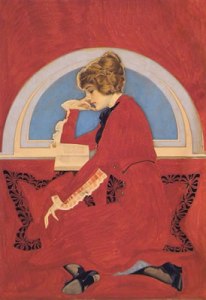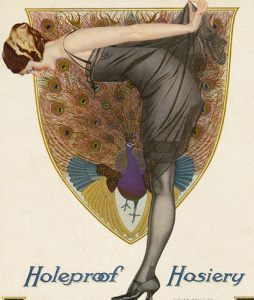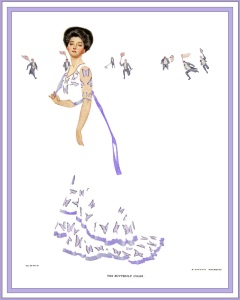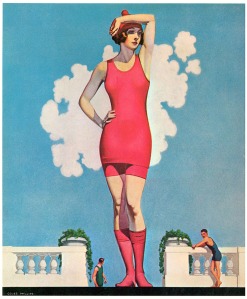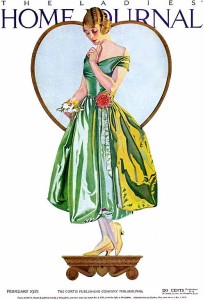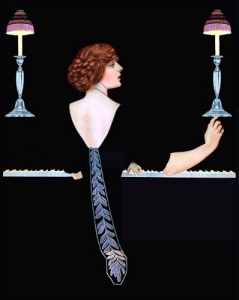A few years ago I saw a book at the store, drawn to the cover art. I didn’t remember what the book was called or who it was by, but I remembered that cover. Early 2014, I found the book again because I remembered the cover. The book is Fadeaway Girl by Martha Grimes. I bought the book and read it (it was fine; turns out it was the latest in a series I hadn’t read), and the book talked briefly about the Fadeaway Girls of artist Coles Phillips. I’ve been a little obsessed with his art ever since. Not just the Fadeaway Girls, but his advertisements and magazine covers too. As of this writing, two of my social media profiles are his work.
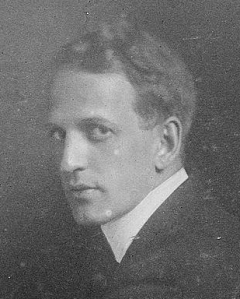 Clarence Coles Phillips was born in October 1880 in Springfield, Ohio. From the age of eight, and throughout his life, he raised pigeons. He was always interested in art, too, but that wasn’t really a viable career in late-1800s Ohio. After Coles graduated high school, his father got him a job at the American Radiator Company in Springfield. Coles didn’t really care for this though and, after securing a letter of recommendation (you can never be too safe), he enrolled at Kenyon College in 1902. While at Kenyon he joined the Alpha Delta Phi literary society, as well as doing illustrations. The 1901-1904 editions of the Kenyon College yearbook, The Reveille, published some of his illustrations. Coles decided that, like American Radiator, Kenyon wasn’t really right for him, and moved to Manhattan after his junior year.
Clarence Coles Phillips was born in October 1880 in Springfield, Ohio. From the age of eight, and throughout his life, he raised pigeons. He was always interested in art, too, but that wasn’t really a viable career in late-1800s Ohio. After Coles graduated high school, his father got him a job at the American Radiator Company in Springfield. Coles didn’t really care for this though and, after securing a letter of recommendation (you can never be too safe), he enrolled at Kenyon College in 1902. While at Kenyon he joined the Alpha Delta Phi literary society, as well as doing illustrations. The 1901-1904 editions of the Kenyon College yearbook, The Reveille, published some of his illustrations. Coles decided that, like American Radiator, Kenyon wasn’t really right for him, and moved to Manhattan after his junior year.
In New York, Coles pulled out that letter of recommendation from his boss at American Radiator in Ohio, and got a job at their New York office, rising up to be a salesman. While at American Radiator, though, Coles was caught with a caricature of his boss and was fired. By chance, a friend of Coles’ told J. A. Mitchell, publisher of Life, what happened. Mitchell offered Coles a job at the humor magazine (not the photo-journalism magazine that would come later). Coles decided to go to art school first though.
For three months Coles took night classes at Chase School of Art. Those three months were the only formal art training he ever had. Coles decided school wasn’t right for him again. He worked for a time at a studio that did assembly-line art; Coles was responsible for feet and ankles (which would come in handy when he did hosiery ads later on). After this he moved briefly to an advertising agency, but decided to open his own instead. In 1906, C. C. Phillips & Co. Agency opened with only two employees, one of whom was Edward Hopper, one of Coles’ former classmates.
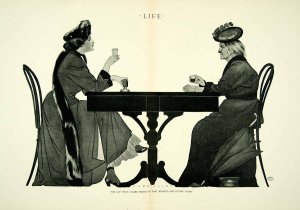 In 1907, Coles met with J. A. Mitchell and was hired on at Life. Coles first nationally published illustration was a black and white centerfold of a young lady across the table from an old lady, captioned with a line from The Rubiyat. This first illustration came out April 11, 1907, and more black and white centerfolds followed. Coles’ art was very popular with Life’s readers.
In 1907, Coles met with J. A. Mitchell and was hired on at Life. Coles first nationally published illustration was a black and white centerfold of a young lady across the table from an old lady, captioned with a line from The Rubiyat. This first illustration came out April 11, 1907, and more black and white centerfolds followed. Coles’ art was very popular with Life’s readers.
That same year, Coles met Teresa Hyde, a nurse. She became his most frequent model in his early years, and in early 1910 they married. From 1905, Coles had been living in New Rochelle, New York. New Rochelle was popular with illustrators at this time and for years afterwards. Illustrators J. C. Leyendecker and Norman Rockwell also lived in New Rochelle.
Shortly after he began at Life, the magazine switched over to color covers and asked Coles to do the art. They wanted something new and distinct to set their magazine apart. Coles gave them his fadeaway idea.
The story goes that Coles got the idea for the fadeaway technique when he was visiting a friend. The friend was dressed in a tux, playing a violin, in a very dimly lit room. Coles couldn’t see all of his friend, but rather the friend was suggested by “the highlights on the violin, the shine on his shoes, and the small bits of white shirt that were visible” (1).
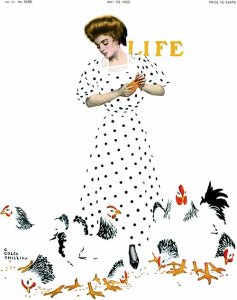 Coles had tried his new technique in black and white, but wanted to try it in color. Doing the fadeaway technique for the magazine cover required studying the proportions of the canvas and the final dimensions for the cover, to make sure the effect would not get lost between painting and printing. Coles’ first cover for Life was February 20, 1908. This played with the ideas he was forming, but wasn’t a true fadeaway image. He continued to tweak his work, and on May 28, 1908, the first Fadeaway Girl cover was published. Like his friend in the tux in the dark, the Fadeaway Girl was “a figure whose clothing matched, and disappeared into, the background” (2).
Coles had tried his new technique in black and white, but wanted to try it in color. Doing the fadeaway technique for the magazine cover required studying the proportions of the canvas and the final dimensions for the cover, to make sure the effect would not get lost between painting and printing. Coles’ first cover for Life was February 20, 1908. This played with the ideas he was forming, but wasn’t a true fadeaway image. He continued to tweak his work, and on May 28, 1908, the first Fadeaway Girl cover was published. Like his friend in the tux in the dark, the Fadeaway Girl was “a figure whose clothing matched, and disappeared into, the background” (2).
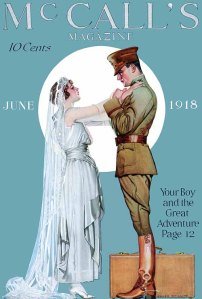 Over the next four years, Coles did over fifty-four covers for Life, moving on to a contract with Good Housekeeping for covers for them for five years, becoming their sole cover artist beginning for two years beginning in July 1912. Other magazines he did covers for included Colliers, Ladies’ Home Journal, McCall’s, Saturday Evening Post, Women’s Home Journal, and Liberty. In the middle of this time, in 1911, Coles Phillips went from C. Coles Phillips to just Coles Phillips. Coles was one of the first illustrators to “insist that his name appear with all his images, including advertising work, and he usually painted a signature in print letters into each work” (3).
Over the next four years, Coles did over fifty-four covers for Life, moving on to a contract with Good Housekeeping for covers for them for five years, becoming their sole cover artist beginning for two years beginning in July 1912. Other magazines he did covers for included Colliers, Ladies’ Home Journal, McCall’s, Saturday Evening Post, Women’s Home Journal, and Liberty. In the middle of this time, in 1911, Coles Phillips went from C. Coles Phillips to just Coles Phillips. Coles was one of the first illustrators to “insist that his name appear with all his images, including advertising work, and he usually painted a signature in print letters into each work” (3).
Part of why the fadeaway technique was so popular, on the publisher’s end, was that, while it was new and striking and popular with audiences left to fill-in the rest of the image themselves, the magazines were “getting by with single color or two-color covers in a day when full-color covers were de rigeur for the better magazines” (4).
In addition to producing art for magazines, Coles was also designing book covers. These covers started quickly after his Life covers. His cover for The Gorgeous Isle by Gertrude Atherton came out in October 1908. Other books Coles did covers or illustrations for included The Siege of the Seven Suitors by Meredith Nicholson, Michael Thwaites’ Wife by Miriam Michelson, and The Fascinating Mrs. Halton by E. F. Benson.
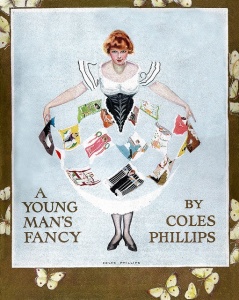 By 1911, Coles Phillips’ art was so popular that a collection of his art from Life and Good Housekeeping was published in the collection A Gallery of Girls. This was followed with another in 1912 called A Young Man’s Fancy.
By 1911, Coles Phillips’ art was so popular that a collection of his art from Life and Good Housekeeping was published in the collection A Gallery of Girls. This was followed with another in 1912 called A Young Man’s Fancy.
At the turn of the century, the Gibson Girl was the popular girl for illustrations and advertisements. She was prim and proper, with big hair and sleepy eyes. The girl of the teens and twenties was modern and athletic. She showed more skin “but she still had a wholesome look to her” (5). Coles Phillips helped popularize this image.
 In addition to his art in books and magazines, Coles Phillips did advertisements too, a rare artist at the time who didn’t see a problem with doing commercial art as well. These advertisements are really what helped popularize the new girl of the teens and twenties. A lot of his ads were for women’s clothing, including hosiery. He also did ads for automobiles and flatware. A lot of the companies he did work for necessitated a more modern and athletic girl than the Gibson Girl had been. You can’t advertise hosiery without showing a girl’s legs. Automobiles were seen as fast and daring, and so the girls became so too. In 1924 he “caused a sensation with his ‘Miss Sunburn’, a bathing beauty created for Unguetine sun tanning lotion” (6).
In addition to his art in books and magazines, Coles Phillips did advertisements too, a rare artist at the time who didn’t see a problem with doing commercial art as well. These advertisements are really what helped popularize the new girl of the teens and twenties. A lot of his ads were for women’s clothing, including hosiery. He also did ads for automobiles and flatware. A lot of the companies he did work for necessitated a more modern and athletic girl than the Gibson Girl had been. You can’t advertise hosiery without showing a girl’s legs. Automobiles were seen as fast and daring, and so the girls became so too. In 1924 he “caused a sensation with his ‘Miss Sunburn’, a bathing beauty created for Unguetine sun tanning lotion” (6).
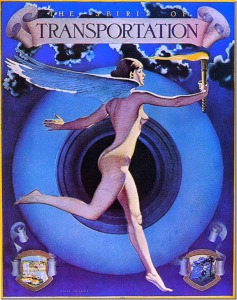 In 1920 Coles Phillips entered the Clark Equipment Company’s “The Spirit of Transportation” competition. While he lost to Maxfield Parrish, James Cady Ewell, and Jonas Lie, his entry took everyone by surprise. While a number of the entries had classical themes, Coles’ had a winged, naked woman carrying a torch in front of an automobile. Like the 1924 Miss Sunburn ad, this was more than audiences were used to seeing in such a modern style. Despite the shock some of his work elicited, Coles’ popularity didn’t diminish. In 1921 and 1922 the U. S. Naval Academy included his work in its yearbook, Lucky Bag. He continued to produced advertisements as well.
In 1920 Coles Phillips entered the Clark Equipment Company’s “The Spirit of Transportation” competition. While he lost to Maxfield Parrish, James Cady Ewell, and Jonas Lie, his entry took everyone by surprise. While a number of the entries had classical themes, Coles’ had a winged, naked woman carrying a torch in front of an automobile. Like the 1924 Miss Sunburn ad, this was more than audiences were used to seeing in such a modern style. Despite the shock some of his work elicited, Coles’ popularity didn’t diminish. In 1921 and 1922 the U. S. Naval Academy included his work in its yearbook, Lucky Bag. He continued to produced advertisements as well.
In 1924, Coles was diagnosed with tuberculosis of the kidney. He’d been sick on and off and would continue to be so until his death. In January of 1927, problems with his eyesight made painting increasingly difficult and so he turned to writing. He didn’t live much longer though. On June 13, 1927, neighbor and friend, J. C. Leyendecker took Coles and Teresa’s four children to Manhattan for the Lindbergh ticker tape parade. While they were out, Coles died at home from his kidney problems. He was just 47.
Coles Phillips’ art during his lifetime and afterwards was featured on “magazine covers, illustrations and ads, postcards, posters, poster stamps, prints, book illustrations, calendars, hosiery and silverware boxes, fans, blotters, streetcar signs, and booklets” (7). In 1993 he was inducted into the Society of Illustrators Hall of Fame (8).
I’m just going to leave you with a bunch of his art (in addition to those scattered throughout this post). I just love his techniques and the overall feel his art has. I hope you all enjoy it as well.
1, 3, 7 – Norm Platnick, “Coles Phillips and the Fade-Away Lady,” American Art Archives.
2, 4 – Coles Phillips
5, 8 – Coles Phillips
